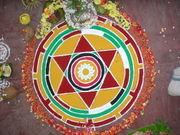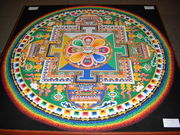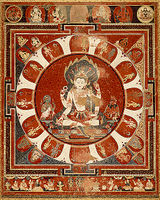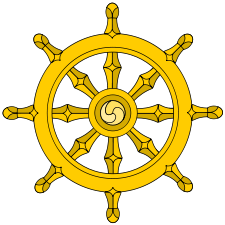Mandala
Mandala (मण्डल) is a Sanskrit word that means "circle". In the Hindu and Buddhist religious traditions, their sacred art often takes a mandala form. The basic form of most Hindu and Buddhist mandalas is a square with four gates containing a circle with a center point. Each gate is in the shape of a T.[1][2]
These mandalas, concentric diagrams, have spiritual and ritual significance in both Buddhism and Hinduism.[3][4] The term is of Hindu origin and appears in the Rig Veda as the name of the sections of the work, but is also used in other Indian religions, particularly Buddhism. In the Tibetan branch of Vajrayana Buddhism, mandalas have been developed into sandpainting. They are also a key part of anuttarayoga tantra meditation practices.
In various spiritual traditions, mandalas may be employed for focusing attention of aspirants and adepts, as a spiritual teaching tool, for establishing a sacred space, and as an aid to meditation and trance induction. According to David Fontana, its symbolic nature can help one "to access progressively deeper levels of the unconscious, ultimately assisting the meditator to experience a mystical sense of oneness with the ultimate unity from which the cosmos in all its manifold forms arises." [5] The psychoanalyst Carl Jung saw the mandala as "a representation of the unconscious self," and believed his paintings of mandalas enabled him to identify emotional disorders and work towards wholeness in personality.[6]
In common use, mandala has become a generic term for any plan, chart or geometric pattern that represents the cosmos metaphysically or symbolically, a microcosm of the Universe from the human perspective.

Contents |
Hinduism

Yantras
The term yantra normally refers to Hindu contexts and practices, while mandala normally refers to Buddhist contexts and practices.April 2010 Yet the terms are also used interchangeably, and mandala is sometimes used as a cross-over term in Hindu contexts.
A yantra is a two- or three-dimensional geometric composition used in sadhanas, or meditative rituals. It is thought to be the abode of the deity. Each yantra is unique and calls the deity into the presence of the practitioner through the elaborate symbolic geometric designs. According to one scholar, “Yantras function as revelatory symbols of cosmic truths and as instructional charts of the spiritual aspect of human experience" [7]
Many situate yantras as central focus points for Hindu tantric practice.Yantras are not representations, but are lived, experiential, nondual realities. As Khanna describes:
Despite its cosmic meanings a yantra is a reality lived. Because of the relationship that exists in the Tantras between the outer world (the macrocosm) and man’s [sic] inner world (the microcosm), every symbol in a yantra is ambivalently resonant in inner-outer synthesis, and is associated with the subtle body and aspects of human consciousness.[8]
Mandala is also the term used to describe the Rig Veda, a sacred Hindu scripture.
Buddhism
_embracing_his_consort_Vajra_Vetali,_in_the_corners_are_the_Red,_Green_White_and_Yellow_Yamari.jpg)
Early and Theravada Buddhism
The mandala can be found in the form of the Stupa[9] and in the Atanatiya Sutta[10] in the Digha Nikaya, part of the Pali Canon. This text is frequently chanted.
Tibetan Vajrayana

A kyil khor (Tibetan: དཀྱིལ་འཁོར; Wylie: dkyil 'khor), Tibetan for mandala in Vajrayana Buddhism usually depicts a landscape of the "Buddha-land", or the enlightened vision of a Buddha, which inevitably represents the nature of experience and the intricacies of both the enlightened and confused mind, or "a microcosm representing various divine powers at work in the universe."[4] Such mandalas consist of an outer circular mandala and an inner square (or sometimes circular) mandala with an ornately decorated mandala "palace"[11] placed at the center. Any part of the inner mandala can be occupied by Buddhist glyphs and symbols,[12] as well as by images of its associated deities, which "symbolise different stages in the process of the realisation of the truth." [13]
Kværne (1975: p. 164) in his extended discussion of sahaja, discusses the relationship of sadhana interiority and exteriority in relation to mandala thus:
"...external ritual and internal sadhana form an indistinguishable whole, and this unity finds its most pregnant expression in the form of the mandala, the sacred enclosure consisting of concentric squares and circles drawn on the ground and representing that adamantine plane of being on which the aspirant to Buddhahood wishes to establish [them]self. The unfolding of the tantric ritual depends on the mandala; and where a material mandala is not employed, the adept proceeds to construct one mentally in the course of [their] meditation." [NB: gendered language repaired in square parenthesis; first example employed "him", the second example "his"][14]
Mandalas are commonly used by tantric Buddhists as an aid to meditation. More specifically, a Buddhist mandala is envisaged as a "sacred space," a "Pure Buddha Realm,"[15] and also as an abode of fully realised beings or deities.[13] While on the one hand, the mandala is regarded as a place separated and protected from the ever-changing and impure outer world of samsara,[16] and is thus seen as a "Buddhafield"[17] or a place of Nirvana and peace, the view of Vajrayana Buddhism sees the greatest protection from samsara being the power to see samsaric confusion as the "shadow" of purity (which then points towards it). By visualizing "pure lands," one learns to understand experience itself as pure, and as the abode of enlightenment. The protection that we need, in this view, is from our own minds, as much as from external sources of confusion. In many tantric mandalas, this aspect of separation and protection from the outer samsaric world is depicted by "the four outer circles: the purifying fire of wisdom, the vajra circle, the circle with the eight tombs, the lotus circle."[18] The ring of vajras forms a connected fence-like arrangement running around the perimeter of the outer mandala circle.[19]
The mandala is also "a support for the meditating person,"[18] something to be repeatedly contemplated to the point of saturation, such that the image of the mandala becomes fully internalised in even the minutest detail and can then be summoned and contemplated at will as a clear and vivid visualised image. With every mandala comes what Tucci calls "its associated liturgy...contained in texts known as tantras,"[20] instructing practitioners on how the mandala should be drawn, built and visualised, and indicating the mantras to be recited during its ritual use.
As a meditation on impermanence (a central teaching of Buddhism), after days or weeks of creating the intricate pattern of a sand mandala, the sand is brushed together and placed in a body of running water to spread the blessings of the mandala.
A mandala can also represent the entire universe, which is traditionally depicted with Mount Meru as the axis mundi in the center, surrounded by the continents.[21] A "mandala offering"[22] in Tibetan Buddhism is a symbolic offering of the entire universe. Every intricate detail of these mandalas is fixed in the tradition and has specific symbolic meanings, often on more than one level.
The mandala can be shown to represent in visual form the core essence of the Vajrayana teachings. In the mandala, the outer circle of fire usually symbolises wisdom. The ring of 8 charnel grounds[23] represents the Buddhist exhortation to always be mindful of death, and the impermanence with which samsara is suffused: "such locations were utilized in order to confront and to realize the transient nature of life."[24] Described elsewhere: "within a flaming rainbow nimbus and encircled by a black ring of dorjes, the major outer ring depicts the eight great charnel grounds, to emphasize the dangerous nature of human life."[25] Inside these rings lie the walls of the mandala palace itself, specifically a place populated by deities and Buddhas.
One well-known type of mandala, in Japan is the mandala of the "Five Buddhas", archetypal Buddha forms embodying various aspects of enlightenment. Such Buddhas are depicted depending on the school of Buddhism, and even the specific purpose of the mandala. A common mandala of this type is that of the Five Wisdom Buddhas (a.k.a. Five Jinas), the Buddhas Vairocana, Aksobhya, Ratnasambhava, Amitabha and Amoghasiddhi. When paired with another mandala depicting the Five Wisdom Kings, this forms the Mandala of the Two Realms.
Offerings
Whereas the above mandala represents the pure surroundings of a Buddha, this mandala represents the universe. This type of mandala is used for the mandala-offerings, during which one symbolically offers the universe to the Buddhas or to one's teacher. Within Vajrayana practice, 100,000 of these mandala offerings (to create merit) can be part of the preliminary practices before a student even begins actual tantric practices.[26] This mandala is generally structured according to the model of the universe as taught in a Buddhist classic text the Abhidharma-kośa, with Mount Meru at the centre, surrounded by the continents, oceans and mountains, etc.
Shingon Buddhism
|
Schools Pure Land • Zen Nichiren |
|
Founders Hōnen • Shinran Dōgen • Eisai • Ingen Nichiren |
|
Sacred Texts Lotus Sutra Prajnaparamita Heart Sutra Infinite Life Sutra Mahavairocana Tantra Vajrasekhara Sutra |
| Glossary of Japanese Buddhism |
The Japanese branch of Vajrayana Buddhism -- Shingon Buddhism—makes frequent use of mandalas in its rituals as well, though the actual mandalas differ. When Shingon's founder, Kukai, returned from his training in China, he brought back two mandalas that became central to Shingon ritual: the Mandala of the Womb Realm and the Mandala of the Diamond Realm.
These two mandalas are engaged in the abhiseka initiation rituals for new Shingon students, more commonly known as the Kechien Kanjō (結縁灌頂). A common feature of this ritual is to blindfold the new initiate and to have them throw a flower upon either mandala. Where the flower lands assists in the determination of which tutelary deity the initiate should follow.
Sand Mandalas, as found in Tibetan Buddhism, are not practiced in Shingon Buddhism.
Nichiren Buddhism
The mandala in Nichiren Buddhism is called a moji-mandala (文字曼陀羅) and is a hanging paper scroll or wooden tablet whose inscription consists of Chinese characters and medieval-Sanskrit script representing elements of the Buddha's enlightenment, protective Buddhist deities, and certain Buddhist concepts. Called the Gohonzon, it was originally inscribed by Nichiren, the founder of this branch of Japanese Buddhism, during the late 13th Century. The Gohonzon is the primary object of veneration in some Nichiren schools and the only one in others, which consider it to be the supreme object of worship as the embodiment of the supreme Dharma and Nichiren's inner enlightenment. The seven characters Nam Myoho Renge Kyo, considered to be the name of the supreme Dharma, as well as the invocation that believers chant, are written down the center of all Nichiren-sect Gohonzons, whose appearance may otherwise vary depending on the particular school and other factors.
Pure Land Buddhism
Mandalas have sometimes been used in Pure Land Buddhism to graphically represent Pure Lands, based on descriptions found in the Larger Sutra and the Contemplation Sutra. The most famous mandala in Japan is the Taima Mandala, dated to approximately 763 CE. The Taima Mandala is based upon the Contemplation Sutra, but other similar mandalas have been made subsequently. Unlike mandalas used in Vajrayana Buddhism, it is not used as an object of meditation or for esoteric ritual. Instead, it provides a visual pictorial of the Pure Land texts, and is used as a teaching aid.
Also in Jodo Shinshu Buddhism, Shinran and his descendant, Rennyo, sought a way to create easily accessible objects of reverence for the lower-classes of Japanese society. Shinran designed a mandala using a hanging scroll, and the words of the nembutsu (南無阿彌陀佛) written vertically. This style of mandala is still used by some Jodo Shinshu Buddhists in home altars, or butsudan.
Christianity

Cowen (2005), states that forms which are evocative of mandalas are prevalent in Christianity: the celtic cross; the rosary; the halo; the aureole; oculi; the Crown of Thorns; rose windows; the Rosy Cross; and the dromenon on the floor of Chartres Cathedral. The dromenon represents a journey from the outer world to the inner sacred centre where the Divine is found.[27]
Similarly, many of the Illuminations of Hildegard von Bingen can be used as mandalas, as well as many of the images of esoteric Christianity, as in Christian Hermeticism, Christian Alchemy, and Rosicrucianism.
Bora ring
A Bora is the name given both to an initiation ceremony of Indigenous Australians, and to the site Bora Ring on which the initiation is performed. At such a site, young boys are transformed into men via rites of passage. The word Bora was originally from South-East Australia, but is now often used throughout Australia to describe an initiation site or ceremony. The term "bora" is held to be etymologically derived from that of the belt or girdle that encircles initiated men. The appearance of a Bora Ring varies from one culture to another, but it is often associated with stone arrangements, rock engravings, or other art works. Women are generally prohibited from entering a bora. In South East Australia, the Bora is often associated with the creator-spirit Baiame.
Bora rings, found in South-East Australia, are circles of foot-hardened earth surrounded by raised embankments. They were generally constructed in pairs (although some sites have three), with a bigger circle about 22 metres in diameter and a smaller one of about 14 metres. The rings are joined by a sacred walkway. Matthews (1897)[28] gives an eye-witness account of a Bora ceremony, and explains the use of the two circles.
Gallery
 A diagramic drawing of the Sri Yantra, showing the outside square, with four T shaped gates, and the central circle. |
 Vishnu-Mandala |
 Painted 19th century Tibetan mandala of the Naropa tradition, Vajrayogini stands in the center of two crossed red triangles, Rubin Museum of Art |
 Painted Bhutanese Medicine Buddha mandala with the goddess Prajnaparamita in center, 19th century, Rubin Museum of Art |
|
Tibetan monks making a temporary "Sand-Mandala" in the City-Hall of Kitzbühel in Austria in 2002 |
 Details of Sand-Mandala |
Mandala of the Six Chakravartins |
 Vajravarahi Mandala |
 Kalachakra Mandala |
 Jain cosmological diagrams and text. |
 Jain painting of Mahavira. |
Mandala painted by a patient of Carl Jung |
See also
- Rose window
- Astrological symbols
- Bhavachakra
- Chakra
- Dharmachakra
- Ganachakra
- Gohonzon
- Kalachakra
- Mandala system
- Namkha
- Quincunx
- Sacred art
- Sand mandala
- Tantra
- Thangka
- Yantra
Notes
- ↑ Artiste Nomade, What's a mandala?
- ↑ Kheper,The Buddhist Mandala - Sacred Geometry and Art
- ↑ "mandala". Merriam-Webster Online Dictionary. 2008. http://www.merriam-webster.com/dictionary/mandala. Retrieved 2008-11-19.
- ↑ 4.0 4.1 Mandala, The Mandala, Mandala Design, Largest Mandala, Buddha's Life Stages in Mandala, Mandala Paintings, Thanka Paintings, Work of Art, Asian art, Asian Paintings, Volunteer Work, Philanthropy, Donation for Preservation of Buddhist Religion
- ↑ See David Fontana: "Meditating with Mandalas", p. 10
- ↑ See C G Jung: Memories, Dreams, Reflections, pp.186-197
- ↑ Khanna, Madhu, Yantra: The Tantric Symbol of Cosmic Unity. Thames and Hudson, 1979, p. 12.
- ↑ Khanna, Madhu, Yantra: The Tantric Symbol of Cosmic Unity. Thames and Hudson, 1979, pp. 12-22
- ↑ Prebish & Keown, Introducing Buddhism, ebook, Journal of Buddhist Ethics, 2005; printed edn, Routledge, 2006; page 89
- ↑ Skilling, Mahasutras, volume II, parts I & II, Pali Text Society, pages 553ff
- ↑ Mandala
- ↑ http://www.jyh.dk/indengl.htm#Symbols Mandala by Jytte Hansen
- ↑ 13.0 13.1 Trans-Himalayan Murals
- ↑ Kvaerne, Per (1975). "On the Concept of Sahaja in Indian Buddhist Tantric Literature". (NB: article first published in Temenos XI (1975): pp.88-135). Cited in: Williams, Jane (2005). Buddhism: Critical Concepts in Religious Studies, Volume 6. Routledge. ISBN 0-415-33226-5, 9780415332262. Source: [1] (accessed; Friday April 16, 2010)
- ↑ Lotsawa House | Chökyi Drakpa | Offering the Mandala
- ↑ Sudden or Gradual Enlightenment
- ↑ http://home.swipnet.se/ratnashri/ngondro.htm
- ↑ 18.0 18.1 Mandala
- ↑ Mandala
- ↑ The Mandala in Tibet
- ↑ Mipham (2000) pp. 65,80
- ↑ The Meaning and Use of a Mandala
- ↑ A Monograph on a Vajrayogini Thanka Painting
- ↑ Charnel Grounds
- ↑ http://www.sootze.com/tibet/mandala.htm
- ↑ Preliminary Practice (Ngondro)
- ↑ See David Fontana: "Meditating with Mandalas", p. 11, 54, 118
- ↑ The Burbung of the Darkinung Tribes, 1897, Matthews, R.H., 1897, Proceedings of the Royal Society of Victoria 10, 1: 1-12.
References
- Brauen, M. (1997). The Mandala, Sacred circle in Tibetan Buddhism Serindia Press, London.
- Bucknell, Roderick & Stuart-Fox, Martin (1986). The Twilight Language: Explorations in Buddhist Meditation and Symbolism. Curzon Press: London. ISBN 0-312-82540-4
- Cammann, S. (1950). Suggested Origin of the Tibetan Mandala Paintings The Art Quarterly, Vol. 8, Detroit.
- Cowen, Painton (2005). The Rose Window, London and New York, (offers the most complete overview of the evolution and meaning of the form, accompanied by hundreds of colour illustrations.)
- Crossman, Sylvie and Barou, Jean-Pierre (1995). Tibetan Mandala, Art & Practice The Wheel of Time, Konecky and Konecky.
- Fontana, David (2005). "Meditating with Mandalas", Duncan Baird Publishers, London.
- Gold, Peter (1994). Navajo & Tibetan sacred wisdom: the circle of the spirit. ISBN 0-89281-411-X. Rochester, Vermont: Inner Traditions International.
- Mipham, Sakyong Jamgön (2002) 2000 Seminary Transcripts Book 1 Vajradhatu Publications ISBN 1-55055-002-0
- Tucci,Giuseppe (1973). The Theory and Practice of the Mandala trans. Alan Houghton Brodrick, New York, Samuel Weisner.
- Vitali, Roberto (1990). Early Temples of Central Tibet London, Serindia Publications.
- Wayman, Alex (1973). "Symbolism of the Mandala Palace" in The Buddhist Tantras Delhi, Motilal Banarsidass.
- Chris Bell (n.d.). The Maṇḍala
External links
- Mandalaweb.info - The world of Mandalas between art and symbols [english/italian]
- Introduction to Mandalas
- Rotation Point Mandala and Frequency Chord Projection by Michael Schreiber, Wolfram Demonstrations Project.
|
||||||||||||||||||
|
|||||||||||||||||||||||||||||||||||||||||||||||||||||||||||



